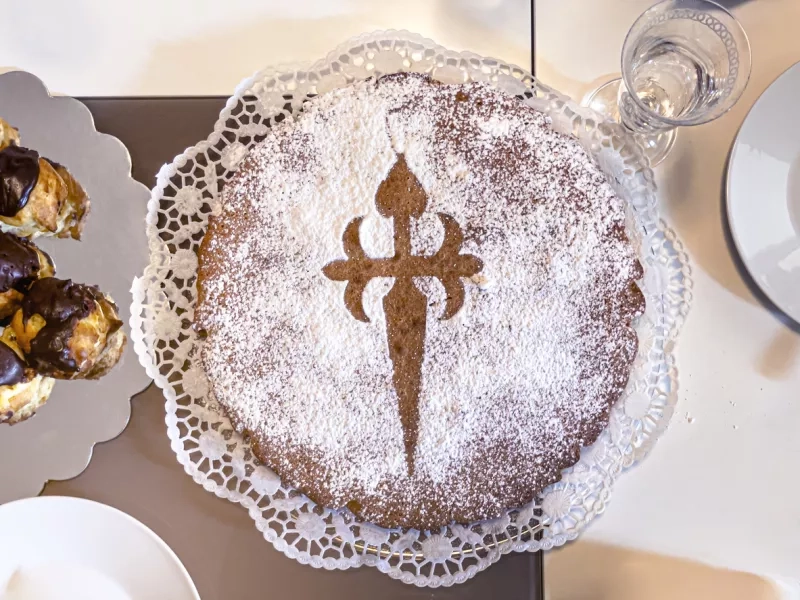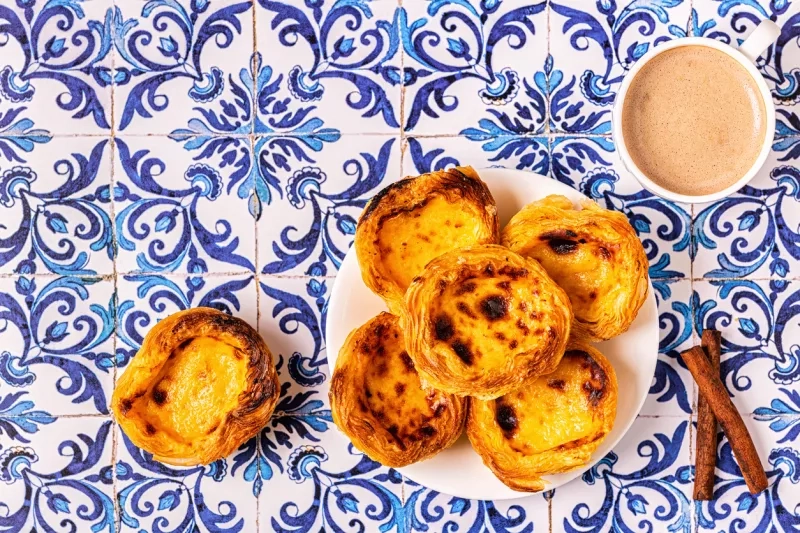
4 Incredible European desserts you need to try
6 Minute Read
Do you have a sweet tooth and love to travel? Then why not embark on a delicious journey across Europe and explore must-try desserts that will tickle your taste buds?
Europe isn’t just about its grand architecture, beautiful landscapes, and rich history – it’s also a haven for dessert enthusiasts. Each of its countries, from Spain’s sun-kissed fields to Turkey’s bustling markets, tells a unique culinary story through its traditional desserts. Whether it’s the nutty delight of Tarta de Santiago, the creamy goodness of Pastel de Nata, the crispy and creamy textures of Cannoli, or the sweet, layered Baklava, each dessert is a journey through the flavours and traditions of its country of origin. So, next time you find yourself in one of these countries, make sure to try these desserts.
Tarta de Santiago Galicia, Spain

Aida Servi | iStock
In the heart of Spain, you’ll find a divine almond cake from the region of Galicia. The cake is named after Saint James, the patron saint of Spain. It is traditionally decorated with the Cross of Saint James, made by stencilling an image of the cross with powdered sugar. Every bite offers a rich and nutty flavour that’s a perfect finish to any meal.
If you’re a fan of almond delights, Tarta de Santiago is a European gourmet adventure you shouldn’t miss. The cake was awarded the status of ‘Guaranteed traditional specialty’ by the European Union in 2006.
While this story is more myth than fact, the truth is that Tarta de Santiago has always been closely associated with the pilgrimage route, Camino de Santiago. Pilgrims often indulge in this almond delicacy as a reward for completing their journey. Over the centuries, the recipe was passed down through generations, gradually evolving into the beloved dessert we know today.
Even today, the Tarta de Santiago remains a beloved tradition, particularly during the Festival of Saint James. The cake is often prepared to symbolize hospitality and shared amongst friends and family as part of the festivities. Its taste and significance remain unchanged, a testament to Spain’s enduring love for this almond delight.
Pastel de Nata - Lisbon, Portugal

tbralnina | iStock
Portugal’s Pastel de Nata, often called a Portuguese custard tart, has a creamy center and flaky, buttery pastry shells. They are an iconic delicacy that is synonymous with Portuguese gastronomy. Each bite of Pastel de Nata is a delightful experience that takes you on a culinary journey through the charming streets of Lisbon.
Although you can find Pastel de Nata in various parts of the world, the ones in Lisbon have a unique taste and authenticity. The original recipe is a well-kept secret of the Fábrica de Pastéis de Belém, a café in Lisbon that has been serving them since 1837. The creation of pastel de nata comes with a history lesson.
This dessert dates back to the 18th century and was originally created by the monks of the Jernónimos Monastery from egg yolks that were left over after whites were used to starch clothing in Lisbon. With the closures of convents and monasteries following the 1820 Liberal Revolution, the monks needed a new source of revenue. They started selling their pastéis de nata at a local sugar refinery, and when the monastery closed in 1834, the monks sold the recipe to the sugar refinery.
In 1837, the owners of the sugar refinery opened Fábrica de Pastéis de Belém, which the same family still owes. The monk’s original recipe is kept in a secret room. So, while other bakeries worldwide may have perfected their pastél de nata recipe, nothing will compare to the original recipe created by the Jerónimos monks. Luckily, you can visit Fábrica de Pastéis de Belém, just a three-minute walk from the Jerónimos Monastery and try the monk’s recipe for yourself.
Every day, locals and tourists alike line up to experience the caramelized top and the creamy custard center, all in a perfectly flaky crust. The tarts are often enjoyed with a sprinkle of cinnamon and powdered sugar and are best served slightly warm, enhancing the creamy, custardy center. Today, this dessert has become a symbol of Portuguese pastry craftsmanship worldwide. Whether served as a breakfast delicacy or a sweet snack with an afternoon coffee, Lisbon’s Pastel de Nata is an enchanting gastronomic experience that shouldn’t be missed during a visit to Portugal.
Try the iconic Pastéis de Belém with a Long-stay Portugal departure from Together. Groups by CAA Travel. This 23-day itinerary features a stay in Lisbon, where you can venture to Fábrica de Pastéis de Belém to learn about the history and try these decadent desserts. Travel with the group through Lisbon before making your way to the Algarve coast for a few weeks, with options to tour nearby towns, embark on a boat cruise, and so much more before heading to Lisbon for your final nights. You’ll enjoy pastel de nata, fresh bread and seafood from the coast.
Cannoli - Sicily, Italy

Leo Stein | iStock
A European dessert tour wouldn't be complete without mentioning Cannoli from Italy. Originating from Sicily, Cannoli are tube-shaped shells of fried pastry dough filled with a sweet, creamy filling usually made from ricotta. The contrasting textures and delightful Cannoli flavours make it a standout favourite among Italy's renowned dessert offerings.
Cannoli, a staple of Sicilian cuisine, has a history as rich and layered as the dessert itself. While the exact origins are unclear, it's believed to have been introduced during the Arab rule in Sicily around the 9th century. The dessert symbolized fertility and was traditionally made during the Carnevale season, a festival just before Lent. The name 'Cannoli,' which means 'little tube,' reflects its unique shape, which is said to have been inspired by the hollow canes in the island's riverbeds.
Over time, Cannoli has transcended its seasonal origins and has become a year-round staple in Italian cuisine. It's now synonymous with Sicilian culture and tradition, with generations passing down their recipe variations.
The dessert's popularity has also spread globally, winning over people's hearts (and taste buds). Whether it's a small bakery in Sicily or an Italian restaurant in New York, the Cannoli continues to be a testament to Italy's exquisite culinary craftsmanship.
Baklava Gaziantep, Turkey

Turkey is home to the famous Baklava. Baklava is a masterpiece of Turkish cuisine consisting of layers upon layers of thin pastry filled with chopped nuts and spices, all drenched in sweet syrup or honey. Each bite promises a taste of the Middle East with rich, sweet, and crunchy textures.
The history of Baklava is as intricate as its delicious layers. Its origin is often disputed, mainly due to its widespread popularity across several Middle Eastern and Eastern European countries. However, it is generally agreed that it emerged during the Ottoman Empire era, with the Ottoman chefs perfecting the recipe and turning it into the pastry we adore today.
The word ‘Baklava’ is derived from the Ottoman Turkish language and means ‘to pile up,’ which explains the preparation method involving stacking numerous thin layers of dough. However, the concept of layered bread dates back to the ancient civilizations of Mesopotamia.
Interestingly, Baklava was once considered a luxury dessert, reserved for the wealthy and special occasions. Only in the 19th century did it become more accessible, following the expansion of its main ingredient, sugar, being available outside of royal kitchens.
Each region has adopted and added its unique touch to this recipe, resulting in a range of Baklava types. For instance, the Gaziantep region in Turkey is renowned for its pistachio Baklava, and it even earned a protected status from the European Commission for its pistachio variety.
Although the Baklava’s roots might seem complex, one thing is sure: its delightful taste and texture continue to captivate dessert lovers.
Pack your bags and your sweet tooth
From touring the Rocky Mountains by rail and Alaska by sea, to 23 days discovering Portugal Together. Groups by CAA Travel has an itinerary for everyone. With the benefit of group pricing and savings exclusive to CAA Members, a group itinerary has so much to offer. The itineraries are always curated with one-of-a-kind experiences that you can’t find on your own, plus there is safety travelling in numbers. You will be joined by like-minded travellers, creating memories and friendships that will last a lifetime. Some group itineraries are hosted by a CAA Host, meaning you will have a trusted and familiar face on your journey.
What are you waiting for? Find your perfect itinerary with a trip from Together. Groups by CAA Travel. Visit us online or book an appointment with a trusted Travel Consultant to plan a trip that will satisfy your cravings for adventure and sweets.




